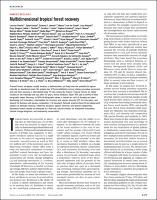Multidimensional tropical forest recovery
Date
12-2021Auteur
Pooter, Lourens
Craven, Dylan
Jakovac, Catarina C
van der Sander, Masha T
Amissah, Lucy
Bongers, Frans
Chazdon, Robin L
Farrior, Caroline E
Kambach, Stephan
Meave, Jorge A
Muñoz, Rodrigo
Norden, Natalia
Rüger, Nadja
van Breugel, Michiel
Almeyda Zambrano, Angélica María
Amani, Bienvenu
Andrade, José Luis
Brancalion, Pedro H. S.
Broadbent, Eben N
Foresta, Hubert de
Dent, Daisy H
Derroire, Géraldine
DeWalt, Saara J
Dupuy, Juan M.
Durán, Sandra M
Fantini, Alfredo C
Finegan, Bryan
63 autores más
Sustainable development goals
ODS 13 - Acción por el clima
Type
Artículo
Metadata
Afficher la notice complèteRésumé
Tropical forests disappear rapidly because of deforestation, yet they have the potential to regrow
naturally on abandoned lands. We analyze how 12 forest attributes recover during secondary succession
and how their recovery is interrelated using 77 sites across the tropics. Tropical forests are highly
resilient to low-intensity land use; after 20 years, forest attributes attain 78% (33 to 100%) of their
old-growth values. Recovery to 90% of old-growth values is fastest for soil (<1 decade) and plant
functioning (<2.5 decades), intermediate for structure and species diversity (2.5 to 6 decades), and
slowest for biomass and species composition (>12 decades). Network analysis shows three independent
clusters of attribute recovery, related to structure, species diversity, and species composition.
Secondary forests should be embraced as a low-cost, natural solution for ecosystem restoration,
climate change mitigation, and biodiversity conservation.
Keywords
Delegation
Sede Central
Éditeur
AAAS, Washington, DC (USA)
Is part of
Science, 374 (6573)
Status
openAccess
xmlui.dri2xhtml.METS-1.0.item-uri-link
https://www.science.org/doi/10.1126/science.abh3629


